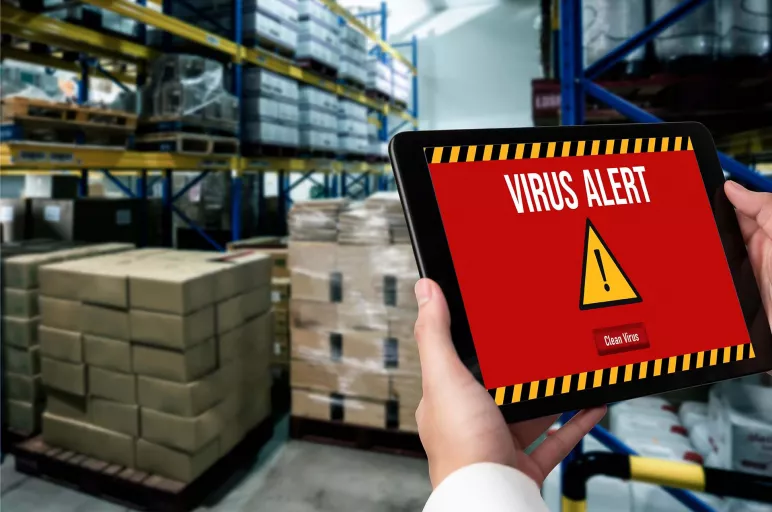
5 Tips to Improve Supply Chain Security
- A risk management program can help identify vulnerabilities and prioritize resources to mitigate risks.
- Companies should monitor their vendor behavior to detect any suspicious activity and potentially fraudulent transactions.
- They should also review physical security practices at supplier sites.
November 22, 2022 | Supply Chain Strategy 4 minutes read
Supply chain security is a risk management priority for companies.
After several high-profile supply chain attacks in the last two years, businesses are recognizing that risk goes beyond IT networks and cyberthreats.
Businesses are beginning to see risks posed by supply chain disruptions as well as physical threats. The risk of third-party vendors adds another layer of complexity because even if you have strong cyber and physical security measures, they’re only as strong as your partners’.
How to Enhance Supply Chain Security
There are many steps you can take to improve your supply chain security:
Build a Risk Management Program
Any business that relies on a supply chain for inventory is vulnerable to disruption. A risk management program can help you identify vulnerabilities, assess the likelihood of a disruption, and prioritize resources to mitigate the risk.
You can start by mapping your supply chain. Who are your top suppliers and why? What countries do they come from, and what is the risk associated with those locations? Are they vendors or partners that are part of your core business model? What are your key performance indicators, and how can you track those KPIs throughout the supply chain?
Track and Monitor Supplier Behavior
It is recommended that companies track and monitor their vendor behavior to identify suspicious activity, potentially fraudulent transactions, or malicious cyber activity. This may include monitoring incoming shipments for quality and safety concerns, like counterfeit goods. You can also use a risk management tool to map your data and track transactional relationships throughout the supply chain.
You can keep a record of who your suppliers are and what they’re providing, as well as any contractual obligations, milestones, or delivery dates. This will help you identify anomalies and potential red flags as they occur. If your supplier stops sending shipments or emails, you’ll see it immediately. If your supplier is communicating in a way that is outside of their normal pattern, you’ll know that as well. You’ll also have a record of the data in case you need to refer to it later.
Review Physical Security Practices
In addition to cyber and data security, you also want to review physical security practices at supplier sites. This could include examining their location and facilities, as well as their security measures. If you’re manufacturing goods overseas, you may partner with a supplier that is located in a different country. If you’re in the IT services business, you may work with an outsourced company in a different part of the world. If you’re buying goods from a supplier that has a small shop in the middle of nowhere with minimal security, you’re at a higher risk of having your goods stolen. If your outsourced services provider is in a building with easy access and minimal security, you’re at a higher risk of having your data breached.
Implement Software and Hardware Measures
Strong cybersecurity is a shared responsibility, and you have to take part in the effort. You need to implement software and hardware measures to protect your data and systems. This will help keep cybercriminals out of your network. You should also protect endpoints—cameras, computers, phones, and other devices on your network. This can be done through cyber threat intelligence tools.
You can also consider using a managed cybersecurity service provider (MSSP) that provides cloud-based security. MSSPs work with you to identify weaknesses in your systems and then devise a plan to fix those weaknesses. Depending on your business, you may need a provider that specializes in financial services, healthcare, or a specific industry.
Also Read: THE GROWING NEED FOR CYBERSECURITY ASSESSMENT SERVICES
Train Employees on Cybersecurity Best Practices
Employees are your first line of defense against cyber threats, but many don’t know how to reduce the risk of attack. Work with your IT team to develop cybersecurity best practices and train employees on them. You can also consider hiring an outside cybersecurity expert to train your team. Experts can walk through common threats and help your team members recognize them. They can also discuss ways to recognize those threats and avoid them. This can help your team members be vigilant about threats and understand how to respond when they encounter them. It will also help you identify where your team members need additional training.
Summing Up
You will never be 100% secure, but you can implement measures that minimize the risk of a breach or attack. When selecting a vendor or partner, make sure they have strong cybersecurity measures in place.
When assessing a potential partner, consider how they manage cybersecurity risk. Look for a vendor who has implemented strong cybersecurity measures and doesn’t have high turnover among staff. Check if they have a team devoted to cybersecurity and the right tools and technologies in place to protect your data.



